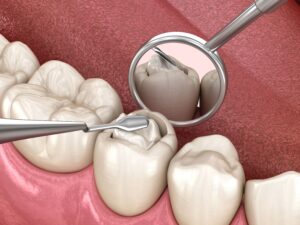Do Dental Restorations Stain?

Dental restorations allow your dentist to effectively treat tooth decay, repair damaged teeth, and even improve the look of your smile. There are a number of different restoration options that can be used depending on the issue, as well as how severe it is. These can include crowns, bridges, fillings, dentures, inlays, onlays, or veneers. There are also different dental materials that can be used to fabricate these restorations.
The materials used to fabricate dental restorations are one of the main factors that affects how long the restoration will last, as well as whether or not it will stain over time. It is also important to note that certain dental materials are often used to fabricate certain restorations. For example, porcelain is generally associated with veneers and composite is associated with fillings.
Although there are many different types of dental materials, we are going to look at two of the most commonly used materials. This is because many dentists now use aesthetic materials like composite resin and porcelain to fabricate the majority of their restorations. While some dentists still use metal restorations, these are no longer as common since they do stain the teeth and possibly the gums.

Since metal has been known to stain the teeth and gums, traditional amalgam fillings are now being replaced with composite fillings. Composite fillings are made from a viscous material known as composite resin. They are fabricated directly inside the mouth and can be easily completed during a single dental appointment. Composite resin can also be customized in terms of both shape and color to match the surrounding tooth structure.
Although composite resin will not stain right away, it can eventually develop stains when regularly exposed to colored pigments. Colored pigments are found in foods and beverages, and it has been noted that composite fillings are especially susceptible to stains from red wine and coffee. People who frequently smoke cigarettes are also more likely to develop yellow or grey stains. However, these same things can stain tooth enamel as well, which may make the stained composite resin less noticeable. The difference is that composite resin will not react to teeth whitening in the same way as tooth enamel.
Composite fillings can also develop stains around the border between the filling and the natural tooth. Usually when this happens, it is because the border has become rough and has started to trap bacteria and food particles. Your dentist may be able to fix this by smoothing out the border or replacing the filling.

Porcelain is another commonly used dental material for the fabrication of indirect restorations. Indirect restorations are carved from a block of porcelain outside of the mouth before they are cemented in place. Porcelain restorations include crowns, bridges, dentures, inlays, onlays, and veneers. As you can see, porcelain is primarily used to fabricate larger restorations since porcelain is stronger than composite resin.
Porcelain also has the added benefit of being stain resistant. This means that as long as your restoration is well taken care of, it should not stain. It is important to note, however, that if the outer glaze becomes damaged or worn, then even your porcelain restoration can stain. To prevent this from happening it is recommended to avoid smoking, brushing too hard, consuming large amounts of acidic foods and beverages, using abrasive toothpastes, or using your teeth as tools.






Recent Comments